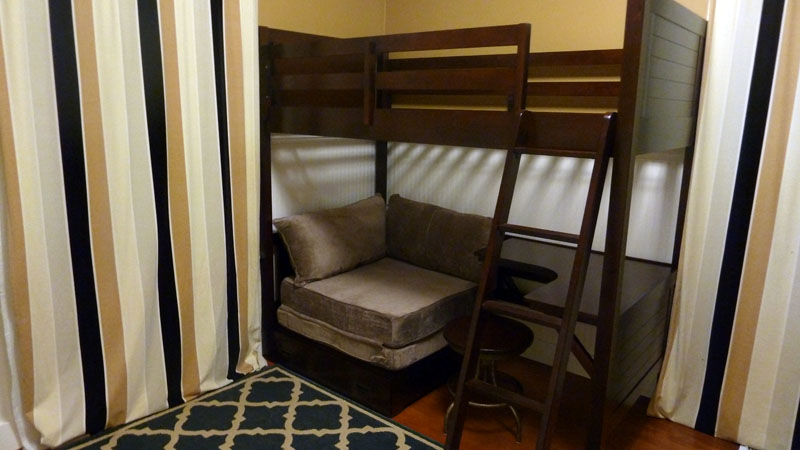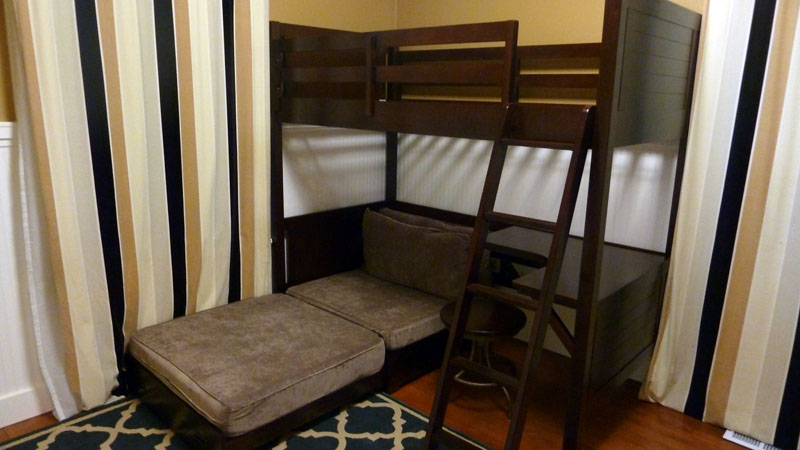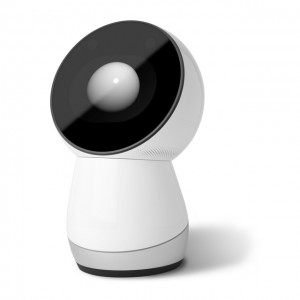Got the new bed set up today.
Here it is with the lower portion in “seat” mode:

And here it is in “bed” mode:

It’s starting to look like a kids’ room!
Got the new bed set up today.
Here it is with the lower portion in “seat” mode:

And here it is in “bed” mode:

It’s starting to look like a kids’ room!
Red light cameras are sold by the companies that install them and the cities that use them as a “safety” feature. Whether or not they actually improve safety is up for debate, but there is no doubt that they are big money makers for the cities that use them. If cities were primarily concerned with safety instead of generating revenue they would get rid of red light cameras and replace them with a yellow light line.
tl;dr – Paint a yellow line on the road. If you’re traveling the speed limit as you approach an intersection and you’ve passed the yellow line when the light turns yellow, just keep going and you’ll clear the intersection before the light turns red. If you’re behind the yellow line, hit the brakes because the light will turn red before you clear the intersection.
Actually there isn’t much more to it than that. Here’s what a city would need to do to implement yellow light lines:
Simple, effective, and cheap.
Intersections controlled by traffic signals have a basic design flaw that red light cameras only serve to exacerbate. Drivers are unsure of how long they have to clear the intersection once the light turns yellow. Should you slow down or speed up? Every intersection has different timing, and when an intersection is equipped with a red light camera that doles out $124 tickets, drivers are much more likely to slam on the brakes even if they could make it through safely. This leads to more rear-end collisions.
With yellow light lines, that ambiguity is completely eliminated with a simple, clear visual. If you’ve passed the line when the light turns yellow, continue on at the speed limit and you will safely clear the intersection before the light turns red. If the line is in front of you, you’ll need to stop. No more uncertainty, no more slamming on the brakes.
In order to help visualize this concept I’ve created this handy calculator. Simply edit the speed limit and/or the yellow light length to see how far from the intersection the yellow light line would be painted.
This section has been added to address some of the objections brought up by Redditors at /r/Seattle.
It’s not illegal to be in the intersection when the light turns red, it’s illegal to enter the intersection after the light turns red. – davethegr8
Indeed, the relevant law here in Washington State (RCW 46.61.055) indicates that it is only illegal to enter the intersection on a red light. However, since the purpose of the yellow light line is not to adhere to strict legal definitions but rather to improve safety, I think it would be best to measure the distance from the end of the intersection rather than the entrance.
How about telling people what you did so they know what the lines are? – Sir_Dude
This is a good point. Above I jokingly said “there is no step 3,” but in reality step 3 would be driver education.
Oh, and how are these lines going to work with heavier vehicles? An SUV is going to need more room to stop than a Prius. One line isn’t going to work for all cars. – Sir_Dude
The yellow light line is not placed based on how long it will take you to stop. The line is placed based on where you can clear the intersection while traveling at the speed limit.
Example: A driver in a Prius is driving the limit on a 35mph road and the light stays yellow for three seconds. They will travel 154 feet during the three seconds that the light is yellow. A driver in a big rig, will still travel the same 154 feet if they are driving 35mph for three seconds. So we paint the yellow light line 154 feet from the end of the intersection.
If three seconds is not enough time for a big rig to stop, then the length of time the light is yellow should be adjusted by the city. This obviously would move the location of the yellow light line, but the correct location of the line is not variable for different vehicles, it depends only on the speed limit and the length of time the light is yellow.
Currently, judgement is all drivers depend on. If you suddenly give drivers a “tip” for determining if they should go or stop, what will change? People tend to be aware of their current speed, their braking capability based on vehicle characteristics, and how far they have before the stop line. – steve_mcgee
It is true that drivers are (or should be) aware of those things. However, what drivers are often unaware of is how long the light will stay yellow, and whether or not that is enough time to make it through the intersection from their location when it turns yellow. This issue is exacerbated by the fact that different intersections have different yellow light timing. The yellow light line is a simple way of providing exactly that piece of information to drivers.
Light timing changes (gets shorter) on many intersections late at night. The timing would be off on clearing the intersection or you’d need two lines. – eran76
The overall cycle of a given traffic signal may get shorter at night, but the length of time the light is yellow is constant regardless of how long the light stays red or green, and does not change throughout the day.
Like this idea? Contact your local city council and point them to this post. Share it on your favorite social media site and spread the word. Or if you’re really ambitious, file a statewide citizen’s initiative. If you feel like living dangerously, you can run the calculator for the intersections in your neighborhood, grab some yellow paint, and engage in some “Guerrilla Public Service” like L.A. artist Richard Ankrom, who installed his own freeway sign in 2001.
I’ve also provided a handy embed code above so you can easily share the yellow light line calculator.
Or maybe you think I’m a clueless idiot and this is an incredibly stupid idea? Point out the flaws in my logic in the comments below.
As always, thanks for reading.
Featured photo by Dan Bates, Everett Herald
Has Seattle traffic suddenly gotten a lot worse, or is it just my skewed perception? I take the Sound Transit 510 express bus from Everett to Seattle every day for work and in the past few weeks I’ve experienced some really excruciating commutes, particularly in the morning on the way into Seattle.
Seattle’s worsening traffic has been the subject of a number of recent articles in both the Seattle Times1 and the Everett Herald2 based on a recent Corridor Capacity Report published by the Washington State DOT. However, this report only covers data through 2013, and my impression has been that things have gotten considerably worse just in the last few weeks.
As it turns out, I just so happen to have been collecting detailed data about my commute for over three years. Since late 2011 I’ve been logging the time at fourteen points along my way to work in the morning and on the way home in the evening. Using this data set, I can visualize my commutes to see if the last few weeks have seen anything truly out of the ordinary.
The plot below has a blue dot indicating the time between boarding the bus in Everett (at 34th & Broadway or 38th & Broadway) every morning and disembarking on one of the first stops (Stewart Street) in downtown Seattle. Orange dots represent the time spent on the bus in the evenings going the reverse direction. The lines are a 30-day rolling average.
After peaking at 56 minutes in late 2012, then peaking at 54 minutes in late 2013, the 30-day average morning commute has risen to an hour and five minutes as of November 3rd.
In fact, six of the ten worst morning commutes I’ve experienced in the last three years have been in just the past three weeks.
| Date | AM Ride |
|---|---|
| 2014-10-20 | 01:49 |
| 2014-10-28 | 01:47 |
| 2014-11-04 | 01:46 |
| 2014-09-24 | 01:44 |
| 2013-11-08 | 01:40 |
| 2012-11-19 | 01:35 |
| 2014-10-23 | 01:33 |
| 2014-10-21 | 01:33 |
| 2012-05-31 | 01:33 |
| 2012-11-01 | 01:33 |
Probably due to the combination of the onset of rainy weather, less daylight, and other factors, the fourth quarter of each of the last three years has seen considerably worse morning traffic than the rest of the year, but this so far year it has been absolutely dreadful.
Interestingly, evening traffic in the opposite direction over this same period has not seen any significant increase compared to last year.
Hopefully the last few weeks have just been a series of terrible flukes, rather than the beginning of a trend of consistently nightmarish morning commutes.
At least I always get a seat on the bus, where I can sleep, read Reddit, or write blog posts like this.
Today we learned that the next consumer version of Windows will be called Windows 10. Some people are a bit confused at this name, since the current version is called Windows 8.1. I say that “Windows 10” is no more nonsensical a name than many of the other previous versions of Windows have been.
Here’s a history lesson for you. The list below contains the names of every consumer version of Windows so far. See if you can spot the pattern…
Hah! It was a trick question! There is no pattern.
Here are the version names from another Microsoft product line you might be familiar with:
So sure, why shouldn’t the next version of Windows be called Windows 10? Microsoft hasn’t bothered with logic in their naming schemes in the past, so why start now?
[July 2015 Update]
Just saw this tweet in an article on The Verge. Seemed appropriate to add here:
Saw this Windows t-shirt at the Microsoft booth today. Check out Windows 9 pic.twitter.com/H4jmi8hPfa
— Tom Warren (@tomwarren) March 2, 2015
 There’s been quite a bit of press recently about a new “family robot” called Jibo. The squat, Pixar-esque robo-assistant has raised over $2 million so far on Indiegogo and spawned dozens of effusive puff pieces across the Internet.
There’s been quite a bit of press recently about a new “family robot” called Jibo. The squat, Pixar-esque robo-assistant has raised over $2 million so far on Indiegogo and spawned dozens of effusive puff pieces across the Internet.
I’m a total sucker for robots and bleeding-edge technology, but the Jibo campaign is throwing up all sorts of red flags for me.
Update: The crew at GeekWire liked my post, so I moved it over there. Read the rest at GeekWire.